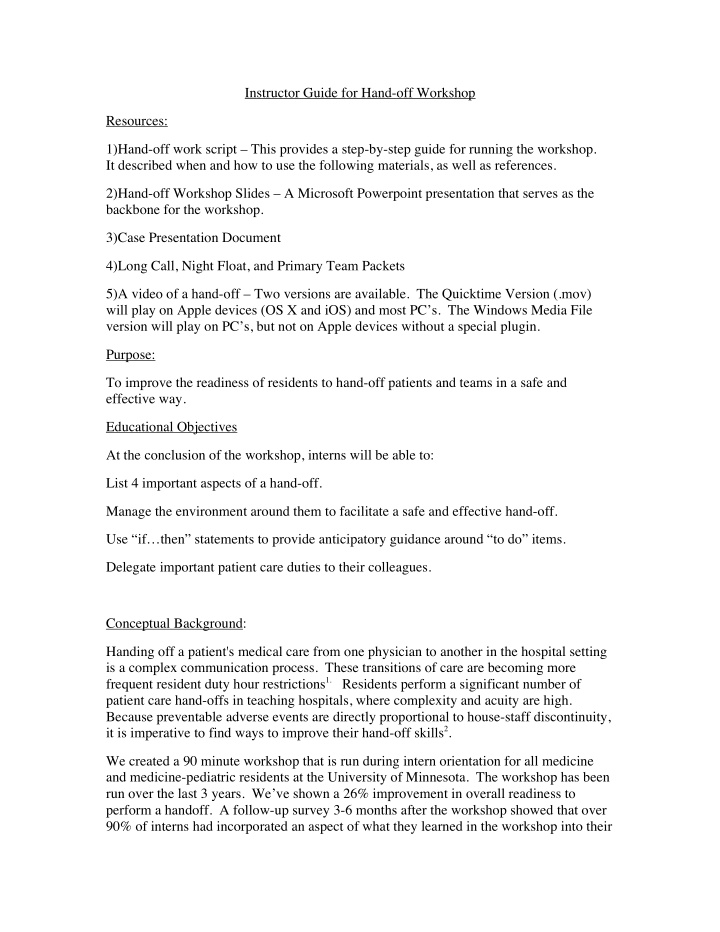



Instructor Guide for Hand-off Workshop Resources: 1)Hand-off work script – This provides a step-by-step guide for running the workshop. It described when and how to use the following materials, as well as references. 2)Hand-off Workshop Slides – A Microsoft Powerpoint presentation that serves as the backbone for the workshop. 3)Case Presentation Document 4)Long Call, Night Float, and Primary Team Packets 5)A video of a hand-off – Two versions are available. The Quicktime Version (.mov) will play on Apple devices (OS X and iOS) and most PC’s. The Windows Media File version will play on PC’s, but not on Apple devices without a special plugin. Purpose: To improve the readiness of residents to hand-off patients and teams in a safe and effective way. Educational Objectives At the conclusion of the workshop, interns will be able to: List 4 important aspects of a hand-off. Manage the environment around them to facilitate a safe and effective hand-off. Use “if…then” statements to provide anticipatory guidance around “to do” items. Delegate important patient care duties to their colleagues. Conceptual Background: Handing off a patient's medical care from one physician to another in the hospital setting is a complex communication process. These transitions of care are becoming more frequent resident duty hour restrictions 1. Residents perform a significant number of patient care hand-offs in teaching hospitals, where complexity and acuity are high. Because preventable adverse events are directly proportional to house-staff discontinuity, it is imperative to find ways to improve their hand-off skills 2 . We created a 90 minute workshop that is run during intern orientation for all medicine and medicine-pediatric residents at the University of Minnesota. The workshop has been run over the last 3 years. We’ve shown a 26% improvement in overall readiness to perform a handoff. A follow-up survey 3-6 months after the workshop showed that over 90% of interns had incorporated an aspect of what they learned in the workshop into their
hand-offs. Full results of the workshop have been published in the Journal of Graduate Medical Education 3 . The workshop is easy to run, is inexpensive, short, and can be easily deployed during resident orientation. Pitfalls/Tips for Success The workshop needs to be carefully facilitated to stay within the time limit. A “dress rehearsal” is probably helpful before deploying the workshop. The facilitator of the workshop should be facile with the hand-off literature, as the majority of the workshop is interactive and a discussion rather then a didactic session. The role-playing session at the end of the workshop is designed to mimic the need to rapidly assimilate and communicate information that happens during the natural hand-offs of a primary team to a call team to a night float team. Interns have some difficulty synthesizing the information and will tend to be overly verbose – they need to be moved along in the process. The whole point is that the process is dynamic, rapid, and requires “thinking on their feet.” Materials Required: Computer and Projector Marker Board/Flip chart Pre-printed packets Limitations The workshop so far has been done only for medicine and medicine/pediatric residents, and the facilitator has been a faculty member. It would be useful to train chief residents to run the workshop to provide more flexibility. The workshop provides a framework for thinking about hand-offs – as best practices are developed and accepted, they should be added to the workshop.
References: 1)Horwitz LI, Krumholz HM, Green ML, Huot SJ. Transfers of patient care between house staff on internal medicine wards: a national survey. Archives of Internal Medicine. 2006;166(11):1173-1177. 2)Petersen LA, Brennan TA, O’Neil AC, Cook EF, Lee TH. Does housestaff discontinuity of care increase the risk for preventable adverse events? Annals of Internal Medicine. 1994;121(11):866-872. 3)Aylward M, Vawter L, Roth C. An Interactive Handoff Workshop to Improve Intern Readiness in Patient Care Transitions. Journal of Graduate Medical Education: 2012:4 (1):68-71.
Recommend
More recommend